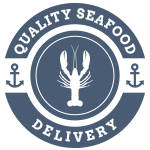It’s easy to think that the main difference in cooking king salmon is the extra thickness of the fillet. Baked or grilled, the ideal cooking time for king salmon is an extra minute or two to compensate for the thickness. Still, it’s not the only difference; it’s not even the biggest difference. The high fat and oil content of king (Chinook) salmon helps protect the rest of the meat during the cooking. A combination of firm thick texture with a bold taste make king salmon the consensus pick as the best salmon you can buy. Many experts consider sushi-grade king salmon to be every bit the delicacy as sushi-grade tuna. Get a great price on your next king salmon feast with our buying guide.
Basic Cooking and Storage Tips
Compared to milder-tasting salmon, Chinook offers a more complex flavor profile which we’ve heard described as slightly nutty. King salmon is the closest thing you can get to a true “salmon steak.” Like steak, it’s a good idea to take your thawed king salmon out of the refrigerator for 30 minutes before cooking and to let it rest for 10-15 minutes after cooking.
The one noticeable downside to this salmon’s high fat content is that it’s harder to preserve over long periods of time. While other salmon may be good for upwards of 6 months, king salmon should usually be eaten within 3-4 months, even when frozen. The thicker portions and fillets also mean you may need to thaw the salmon at least 24-36 hours beforehand.
Easy Cooking that Highlights the Natural Flavor
Beginners may be concerned about putting the perfect cook on this expensive salmon, but know that you have a little more room for error with king salmon. The “stable” meat of Chinook king salmon holds up well on the grill (gas or charcoal) as well as pan-seared. Ever have trouble getting the perfect slightly blackened outside with a slightly moist and flaky inside? Nothing is certain, but you have a much better chance with king salmon.
For this reason, king salmon is often described as being a versatile choice for different salmon recipes. But versatile cooking is in the eye of the beholder. For people whose favorite salmon recipe calls for heavier seasoning, king salmon may not be the best choice. It’s not that you can’t or shouldn’t season this salmon, but the expert’s advice is almost always to go on the lighter side to let the natural flavor of king salmon shine through. Plus, if you overwhelm the flavor of king salmon, you might as well opt for similar but more modestly priced sockeye salmon.
King Salmon Portions vs. Fillets
For the most part, the potential hassle in cutting and serving a whole fillet after it’s cooked—not to mention the added difficulty of judging the cook time for such a large fillet—means it’s usually a better choice to use pre-cut portions. You can do this yourself, or simply order king salmon portions from the start. One reason you might think about cooking a whole king salmon fillet is to impress your guests or create a photo-op. A whole fillet might be 10-40 pounds, so it’s important to have a plan for whole fillets before placing your order. If you’re using a larger smoker or a larger cedar plank that can fit an entire king salmon fillet, this is one sure-fire way to wow your guests. Especially if you feel confident in your cooking method.
Different Methods for Cooking King Salmon
Grilled, baked, pan-seared, broiled, or even poached, there’s no wrong way to cook king salmon. Most people choose to cook with the skin-on. Some people prefer to grill king salmon on cedar planks. This method is a favorite for Chinook, as well as other types of salmon. Likewise, the higher heat of grilled and pan-seared methods typically create a slightly crispy or blackened surface, while still leaving moisture in the middle. Broiled and baked salmon create a more consistent cook throughout the salmon.
Take note of our Affiliate Relationships that may exist with this page and companies listed on it.

